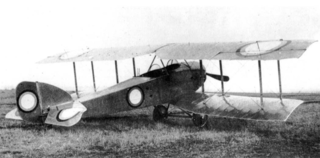 W
WThe Anatra D or Anade was a two-seat reconnaissance aircraft built in Odessa, Russian Empire and flown during World War I. It was a two-bay biplane of conventional configuration that seated the pilot and observer in tandem, open cockpits. Test flights revealed a number of design flaws, including weak wing structure that would later kill the company test pilot on 21 July 1917 and poor stability. Despite the problems, the aircraft was ordered into production by the Army, and deliveries commenced in May 1916 after revisions had been made to correct the aircraft's centre of gravity in the hope of addressing the worst handling problems. The type continued in limited service after the war, eventually being used as a trainer until about 1919.
 W
WThe Anatra DS or Anasal was a two-seat reconnaissance aircraft developed from the Anatra D (Anade). It was built in the Anatra factory in Odessa in the Russian Empire and flown during World War I by both sides during the Russian Civil War.
 W
WThe Henry Farman HF.30 was a two-seat military biplane designed in France around 1915, which became a principal aircraft of the Imperial Russian Air Service during the First World War. Although it was widely used on the Eastern Front, and by the factions and governments that emerged in the subsequent Russian Civil War, it is not well known outside that context: the HF.30 was not adopted by other Allied air forces, and the manufacturers reused the "Farman F.30" designation for the Farman F.30 in 1917.
 W
WGrigorovich M-5 was a successful Russian World War I-era two-bay unequal-span biplane flying boat with a single step hull, designed by Grigorovich. It was the first mass production flying boat built in Russia.
 W
WGrigorovich M-9 was a Russian World War I-era biplane flying boat, developed from the M-5 by Grigorovich.
 W
WGrigorovich M-15 was a successful Russian World War I-era biplane flying boat, developed from the M-9 by Grigorovich.
 W
WThe Lebed XII was a Russian military reconnaissance aircraft produced during the First World War for the Imperial Russian Air Force. It was one of the few domestically designed aircraft to see production in Russia during the war, but was based on designs and techniques learned from Lebed's rebuilding of captured German types. The fuselage was a plywood structure of rectangular cross-section with seating for the pilot and observer in tandem, open cockpits. The wings were built around a pine spar and covered in fabric, and the empennage was of welded steel tube with fabric covering.
 W
WThe Sikorsky S-10 was a Russian military twin-float seaplane that served with the Russian Navy's Baltic Fleet from the summer of 1913 to 1915. After Igor Sikorsky built the successful Sikorsky S-6 for the Russian military, he tried to build another successful aircraft for them. The S-10 was a modified S-6B built by the Russo-Baltic Carriage Factory. Approximately sixteen production versions of the S-10 were built. It had a less powerful engine and generally weaker structure than the S-6. They had either an 80 hp Gnome Monosoupape or a 100 hp Argus Motoren engine. Some were deployed on the world's first operational seaplane carriers.